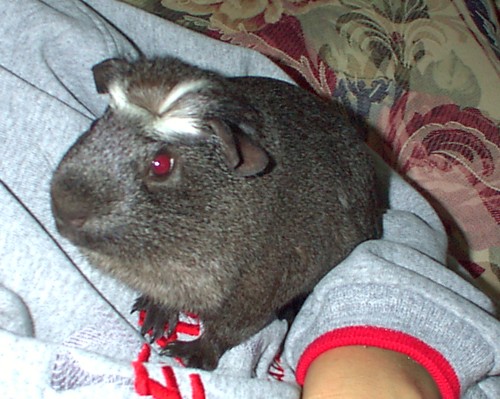
Skunkie the Guinea Pig
The Newest addition to the Rutherford Clan. (Skunkie) the Guinea Pig Born January 3 2003. He is a Short Haired-Silky. He is very timid and likes to hide under the bed.
Scientific name: Cavy or Guinea Pig
Description:
General Information: This small animal is native to the temperate zones of the Andes Mountains in Peru. They develop an intense affection towards their owners and have been known to whistle and chirp with delight when their owner enters the room. They are gentle animals
and make great pets for older children who can handle them gently. They are social animals and enjoy interacting with their owner. Guinea Pig varieties are distinguished by the texture, length, color of their hair, and by coat patterns. The correct name of a guinea pig is "cavy" (rhymes with gravy), although this term
is usually only used by people who show and breed guinea pigs.
A high quality guinea pig food should always be available. Guinea pigs differ from other rodents in that they cannot manufacture Vitamin C. Therefore, it is essential that this vitamin be provided for them in their food. It is recommended that you feed Nutriphase Guinea Pig food as a staple part of their diet, plus Timothy or alfalfa hay. As with all pets, fresh water should always be available. Green leafy vegetables should be fed in limited amounts only. This can include kale, parsley, cabbage, sprouts, and dandelions. Carrots, apples, and some soft fruits are also a great supplement to their diet, especially sliced oranges that provide Vitamin C. If you serve any fresh food, always remove any uneaten portion after a few hours to avoid bacteria growth. You can also serve treat sticks that will help them keep their teeth worn down, and the guinea pig will enjoy these.
Housing:
The minimum size requirements for a guinea pig cage is two square feet per guinea pig. The cage can be entirely metal, or a combination of metal and hard plastic. The floor should be solid and not wire. Wire can make a guinea pig's feet tender and their little toes might get caught in
it. Guinea pigs require a lot of ventilation, although they should never be placed in a drafty area. Aquariums are not appropriate because they can be too small, and they do not provide enough ventilation that may create an environment that is too humid and warm. Guinea pigs are
sensitive to fluctuations in temperature and prefer a range between 68 and 72 degrees Fahrenheit. They are susceptible to overheating and should not be kept in direct sunlight. The best type of litter is a dust free shaving such as Aspen or Care Fresh. A nest box, water bottle, and sturdy food dish are also required.
Handling:
Guinea pigs, although shy, are one of the easiest small animals to handle. All small animals should be handled gently so as not to frighten them. Using smooth and gentle movements and gripping firmly, but not tightly, place one hand across the shoulders with the thumb over
and around the neck. The other hand should support the back end of the guinea pig.

Size - Weight:
Social Behaviors:
Guinea pigs are social animals and prefer to live with other guinea pigs.
Health:
Guinea pigs are weaned at 3 weeks of age. A male guinea pig is called a boar and a female is called a sow. A healthy guinea pig should have a firm body that is well fleshed with no prominent bones. The coat should be even with no bald patches, signs of wounds, or scratches. The eyes should
be bright with no discharge or cloudiness. The ears should be clean inside with no inflammation. The nose should be clean, without a lot of sneezing or discharge. The breathing should be even with no coughing or wheezing.
Special Requirements:
All rodents have incisor teeth that constantly grow. In a captive environment, these teeth can grow to a length that makes it difficult for them to eat. To prevent this, an abrasive gnawing material (such as a chew stick or chew treat) should be provided at all times. Guinea pigs are
vocal animals and will whistle or squeak to their owners. Guinea pigs are social animals and prefer to live with other guinea pigs. Unless breeding is the goal, it is best to keep two of the same sex together. Most females can live together but only males that have been raised together as babies should be kept together
as adults.
Availability: Readily available.
Activities:
Guinea pigs are diurnal, which means they are most active during the day. In fact, they require very little sleep, needing only 4-6 hours of sleep each night.
Problems:
Guinea pigs are vocal animals and will whistle or squeak to their owners.
![]()
